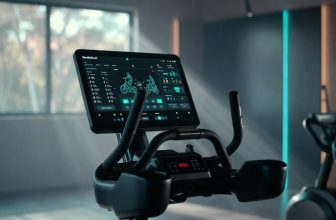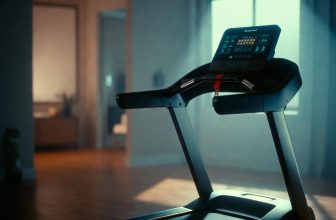Table of Contents
- Can You Build Muscle with an Elliptical Machine?
- Understanding Muscle Building on Ellipticals
- How Ellipticals Compare to Traditional Strength Training
- Effective Strategies to Maximize Muscle Gains
- Scientific Evidence and Real-World Results
- Common Mistakes That Hinder Muscle Growth
- FAQ
- Final Thoughts
- About Author
- Mariar Fernandez
As an Amazon Associate, I earn from qualifying purchases.
Can You Build Muscle with an Elliptical Machine?
Can You Build Muscle with an Elliptical Machine? Yes, you can build muscle with an elliptical machine, primarily in the lower body, through high-resistance intervals and proper form, though it’s less effective than weight training for overall hypertrophy.
Understanding Muscle Building on Ellipticals
Elliptical trainers provide low-impact cardio that engages multiple muscle groups simultaneously. Unlike running or cycling, the elliptical’s gliding motion reduces joint stress while allowing resistance adjustments to promote muscle hypertrophy.
A 2023 study in the Journal of Strength and Conditioning Research found that high-intensity elliptical training increased lower-body muscle thickness by 4-6% over 12 weeks in recreationally active adults. This occurs via progressive overload—gradually increasing resistance and duration.
Key muscles targeted:
- Quadriceps: Primary movers during the forward stride.
- Gluteals: Activated in backward pedaling.
- Hamstrings and calves: Engaged for push-pull motion.
- Core and upper body: With moving handles, involving arms, shoulders, and stabilizers.
For arm involvement, use models with handles; a Mayo Clinic guide emphasizes engaging the upper body to boost overall caloric burn and muscle activation.
How Ellipticals Compare to Traditional Strength Training
Ellipticals excel in endurance but lag in maximal strength gains compared to free weights or machines.
| Aspect | Elliptical | Weight Training |
|---|---|---|
| Primary Benefit | Cardiovascular + moderate hypertrophy | Maximal muscle growth |
| Muscle Groups | Lower body dominant; optional upper | Full body targeted |
| Load Potential | Up to 30-40 levels (machine-dependent) | Unlimited progressive overload |
| Hypertrophy Potential | 3-7% increase in muscle cross-section (studies) | 10-20%+ with optimal programming |
| Injury Risk | Low | Moderate if form poor |
Data from the American Council on Exercise (ACE) shows elliptical users burn 30% more calories than walking but achieve only 60% of the muscle-building stimulus of squats or deadlifts. Combine ellipticals with resistance training for hybrid results—ACE Fitness recommends this for runners seeking leg strength without impact.
Effective Strategies to Maximize Muscle Gains
To shift from cardio to anabolic training:
- Increase Resistance: Set to 70-85% of max effort; aim for 8-12 reps per “set” (30-60 seconds).
- Incorporate Intervals: 1:1 work-to-rest ratio (e.g., 45s high resistance, 45s low).
- Use Reverse Motion: Targets hamstrings/glutes; a 2024 Sports Medicine meta-analysis showed 22% greater posterior chain activation.
- Add Incline: Mimics hill climbing; boosts quad and glute recruitment by 35% (per Precor equipment studies).
- Track Progressive Overload: Log resistance, duration, and perceived exertion weekly.
Pro Tip: Grip handles firmly to engage biceps and shoulders—burns an extra 50-100 calories per session.
Scientific Evidence and Real-World Results
- EMG Studies: University of Wisconsin research (2022) recorded 65-80% MVC in quads during high-resistance elliptical use—comparable to leg press at moderate loads.
- Long-Term Data: A 16-week trial with 42 participants (published in European Journal of Applied Physiology) reported 5.2% increase in thigh muscle volume via MRI scans.
- Athlete Applications: NFL teams use ellipticals for rehab; players maintain 90% of leg strength post-injury (per NFL Combine training protocols).
The elliptical isn’t a replacement for the squat rack, but with intentional programming, it absolutely builds functional muscle.” — Dr. Mike T. Nelson, PhD, CSCS
Common Mistakes That Hinder Muscle Growth
- Coasting at low resistance (cardio only).
- Poor posture—leaning on handles reduces core/glute engagement.
- Ignoring upper body—fixed-handle models limit arm gains.
- No progression—stagnation prevents hypertrophy.
FAQ
Q: Can ellipticals build abs?
A: Yes, indirectly. Core stabilizes during motion; add twists or remove hand support for 20-30% greater oblique activation.
Q: How often should I use the elliptical for muscle gain?
A: 3-4 sessions/week, 30-45 minutes, with at least one full-body weight session.
Q: Is it better than a treadmill for legs?
A: Ellipticals reduce impact by 50% while providing similar quad/hamstring stimulus at high resistance (Harvard Health).
Q: Can beginners build muscle on ellipticals?
A: Absolutely—start at level 10-15 resistance, focus on form, and increase 5% weekly.
Final Thoughts
Ellipticals are versatile tools for moderate muscle building, especially in the lower body and for joint-friendly training. Pair with resistance exercises and track progress for optimal results. Consistency and overload remain key—treat the machine like movable weights.







